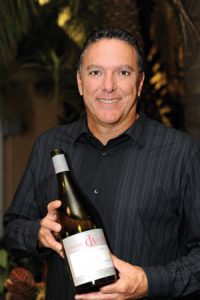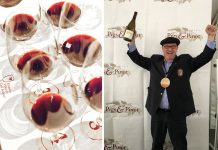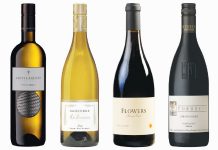By Charles Fredy
 Unless you’re a connoisseur of wines, this has probably happened to you: You go into the store, hoping to find a selection that will offer value for the price . . . and walk up to an intimidating wall of wines. Amid that massive display of reds and whites, about all the direction you’re given is price, color and varietal.
Unless you’re a connoisseur of wines, this has probably happened to you: You go into the store, hoping to find a selection that will offer value for the price . . . and walk up to an intimidating wall of wines. Amid that massive display of reds and whites, about all the direction you’re given is price, color and varietal.
How do you choose?
Read the back label. Wineries want to catch your eye, and will use color, design, even whimsical characters on the front of the bottle, but none of those have anything to do with the quality of the wine. Price may not, either. Some wines are priced artificially high, then discounted substantially to create the illusion of value.
No, the flashy front label won’t tell you much—but the back label can be a wealth of information, beginning with the actual components of the wine. For example, the front of the bottle might say “cabernet sauvignon,” while the back reveals that it’s 75 percent cabernet sauvignon, 25 percent syrah. If you like syrah, you might enjoy the wine.
Some back labels provide a flavor profile and suggest pairings, telling you, for instance, that this is a robust and full-flavored wine that goes wonderfully with roast chicken or beef. But keep in mind that the accuracy of the flavor profile isn’t monitored, the way varietals and regions are.
One of the best clues to a wine’s real value is where the label says it comes from. Usually, the smaller the region, the higher the quality. Let’s say you’re looking at a red whose region is listed as “California.” The winemaker could have bought fruit in bulk from anywhere in the state. If the label says “Napa Valley,” the majority of the fruit had to come from that region. Better yet is a label that lists a subregion, like Oakville or Carneros, or even a single vineyard. Bottling from a small plot of land requires more careful treatment than does buying grapes or wine from a large area.
Next time, we’ll talk about what ratings and vintages can reveal, why consistency is important, and when to choose an older or younger wine. For now, here are some wines I’d label “small and delicious.”
+ Dashe Cellars, Dry Riesling, McFadden Farms, Potter Valley, 2009
+ Talley Vineyards, Chardonnay, Estate, Arroyo Grande Valley, 2008
+ Shafer Vineyards, Chardonnay, Red Shoulder Ranch Vineyard, Carneros, 2008
+ Molnar Family Vineyards, Pinot Noir, Poseidon’s Vineyard, Carneros, 2007
+ Soter Vineyards, Pinot Noir, Mineral Springs Ranch, Yamhill-Carlton District, 2008
+ Obsidian Ridge Vineyards, Cabernet Sauvignon, Red Hills, Lake County, 2007
Charles Fredy is an advanced sommelier with the Court of Master Sommeliers, and a certified specialist of wine with the Society of Wine Educators. A thirty-two-year veteran of the wine-and-spirits industry, he is director of sales and marketing for Chambers and Chamber Wine Merchants Hawai’i.





